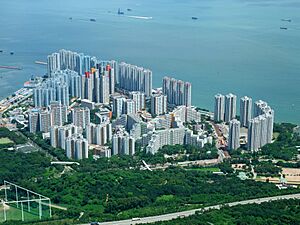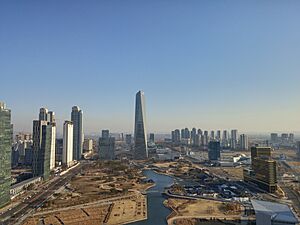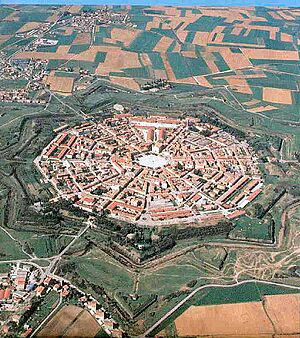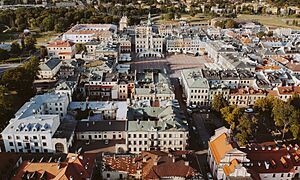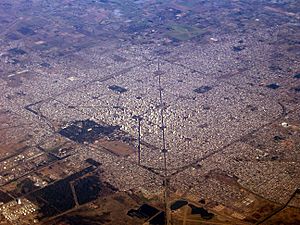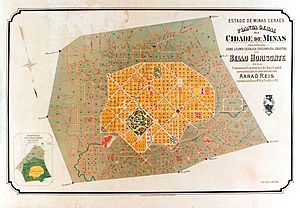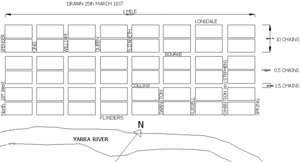Planned community facts for kids
A planned community is a city, town, or neighborhood that was carefully designed and built from the very beginning. Unlike places that grow slowly over time, planned communities are often built on land that was empty before. They have a clear layout for streets, buildings, and parks.
The idea of "new towns" became popular, especially in the United Kingdom, to describe planned communities built after World War II. Even long ago, during the European colonization of the Americas, many settlements were built following a specific plan, sometimes even on the ruins of older Native American villages.
Contents
- Planned Capital Cities
- Planned Cities in Africa
- Planned Cities in Asia
- Planned Cities in Europe
- Planned Cities in North America and the Caribbean
- Planned Cities in South and Central America
- Planned Cities in Oceania
- See also
Planned Capital Cities
A planned capital is a city specially designed and built to be the capital of a country. Many countries have planned capitals because it helps to create a central, neutral place for government.
Some examples of planned capital cities around the world include:
- Canberra in Australia
- Brasília in Brazil
- Belmopan in Belize
- New Delhi in India
- Abuja in Nigeria
- Islamabad in Pakistan
- Naypyidaw in Myanmar (Burma)
- Washington, D.C. in the United States
- Modern parts of Astana in Kazakhstan
- Ankara in Turkey
A new capital city is also being built east of Cairo in Egypt. Putrajaya, the main administrative and legal center of Malaysia, is another planned city. Sejong in South Korea was built to be a planned administrative capital.
Planned Cities in Africa
Botswana
The city of Gaborone was planned and built in the 1960s.
Egypt
Company Towns in Egypt
During the building of the Suez Canal in the 1860s, new towns were planned to support the new international shipping route. These were often "company towns," built by a company for its workers. Smaller company towns were also built in the 20th century for oil sites and factories.
- Port Fuad
- Port Tewfik
- Ismailia
- Ras Ghareb
- Mosta'maret al-Mahallah
New Urban Communities in Egypt
Since the late 1970s, Egypt has focused on building new towns in desert areas. These are managed by the New Urban Communities Authority.
- 6th of October (city)
- 10th of Ramadan (city)
- 15th of May
- Badr
- New Borg El Arab
- El Shorouk
- New Cairo
- New Damietta
- Obour (city)
- Sheikh Zayed
Ancient Planned Cities in Egypt
Egypt has a long history of planned cities, dating back thousands of years.
- Memphis, Egypt was the first capital of Egypt, built around 3150 B.C.
- Akhetaten was built by King Akhenaten in the 14th century B.C. and served as his capital.
- Pi-Ramesses was built by Ramesses II in the 13th century B.C. It was a capital city and one of the first cities to have over 100,000 people.
- Alexandria was built by Alexander the Great in the 4th century B.C. It was the first city to reach a population of half a million.
- Fustat was built around the 7th century A.C. to be Egypt's capital after it was conquered.
- Cairo was built in the 10th century A.D. by the Fatimid Caliph Al Muizz.
Equatorial Guinea
In 2012, President Teodoro Obiang decided to move the capital to a new jungle site at Oyala.
Kenya
Konza Technology City is a planned city that aims to become a major center for science and technology in Africa by 2030. Tatu City is another planned city in Kiambu county.
Nigeria
The capital, Abuja, is a planned city built mostly in the 1980s. Other cities are being developed to handle Nigeria's fast-growing population.
- Eko Atlantic City is a planned city in Lagos State built on land reclaimed from the ocean. It is expected to house 250,000 people.
- Centenary City in the Federal Capital Territory is a planned "smart city" designed to attract tourists.
- Other planned areas include Banana Island, Bonny Island, Festac Town, Ikeja, Lekki, and Victoria Island in Lagos.
Senegal
Akon City is Senegal's first planned city, co-planned by the Senegalese-American singer Akon.
South Africa
Many cities in South Africa were planned from their early stages, with their original centers often laid out in a grid pattern. Some planned settlements were also created for specific ethnic groups during the apartheid era.
- Planned settlements for white inhabitants included Welkom, Sasolburg, and Secunda.
- Bisho was a planned capital for a former homeland.
Planned Cities in Asia
Hong Kong
Hong Kong started building new towns in the 1950s to house its quickly growing population. These "satellite towns" were carefully planned for land use, public housing, and transportation.
- Early new towns included Tsuen Wan and Kwun Tong.
- Later new towns from the 1960s and 1970s include Sha Tin, Tuen Mun, and Tseung Kwan O.
- More recent developments are Tin Shui Wai and North Lantau.
- There are nine new towns in total: Tsuen Wan New Town, Sha Tin New Town, Tuen Mun New Town, Tai Po New Town, Fanling-Sheung Shui New Town, Yuen Long New Town, Tseung Kwan O New Town, Tin Shui Wai New Town, and North Lantau New Town.
Indonesia

- Jakarta: The city's predecessor, Batavia, was a planned city in the 17th century, designed with canals and a grid. Later, the Dutch colonial government moved its center to the planned Weltevreden area (now Central Jakarta). Menteng, a sub-district in Central Jakarta, was also built as a planned community for Dutch people and officials in the 1910s.
- Bandung: In the early 20th century, the Dutch East Indies government planned Bandung to be a new capital, separate from the busy trading port of Batavia. Many government buildings were constructed, but the plan failed due to the Great Depression and World War II.
- Palangkaraya: Indonesia's first president, Sukarno, planned to develop Palangkaraya as a future capital because it is larger than Jakarta and safer from earthquakes and volcanoes.
- Nusantara: Due to problems in Jakarta, President Joko Widodo announced in 2019 that Indonesia would move its capital to a new planned city in East Kalimantan province. Construction began in 2020, and the new capital is expected to open in 2024.
Iran
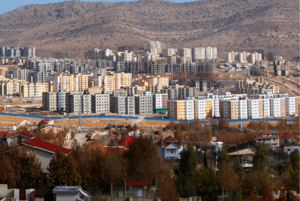
In the Persian Safavid Empire, the capital city of Isfahan was built with a planned layout, including a long boulevard and organized housing. Today, more than 20 planned cities have been built or are under construction in Iran, mostly around major cities like Tehran, Isfahan, Shiraz, and Tabriz. Some are built for special purposes:
- Pardis is a scientific city.
- Poulad-Shahr is an industrial city for steel workers.
- Parand provides homes for staff of Imam Khomeini International Airport.
Israel
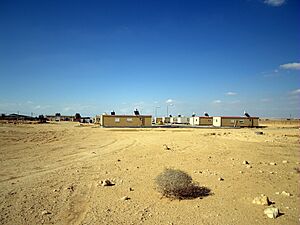
Israel has created many planned cities, especially in less developed regions. These are often called "Development Towns."
- Ashdod is a very successful planned city with over 200,000 people, a port, and good infrastructure.
- Other successful planned cities include Shoham, Karmiel, Arad, and Modi'in-Maccabim-Re'ut. Modi'in-Maccabim-Re'ut started construction in 1994 and now has over 80,000 people.
Malaysia
Malaysia has several planned cities, including:
- Kuala Kubu Bharu
- Bandar Baru Bangi
- Shah Alam
- Putrajaya, Malaysia's new administrative capital
- Cyberjaya
- Petaling Jaya (New Town)
- Kulim Hi-Tech Park
- Iskandar Puteri
- Iskandar Malaysia
Japan

- Kyoto was built as a planned city in 794, with a grid layout, and was the imperial capital for over 1,000 years. Its grid system is still visible today.
- Sapporo was built from 1868 following an American grid plan and is now Japan's fifth-largest city.
- Since the 1960s, about 30 new towns have been built across Japan, many near Tokyo and the Kansai region. Some, like Tama New Town, are "dormitory towns" where people live and commute to nearby cities for work.
- Japan also developed "technopolis" cities, like Tsukuba Science City, which bring together high-tech industries and research.
Myanmar
Naypyidaw is the capital of Myanmar. It was officially moved to this new, planned location on November 6, 2005. Much of the city was still being built as late as 2012.
Pakistan
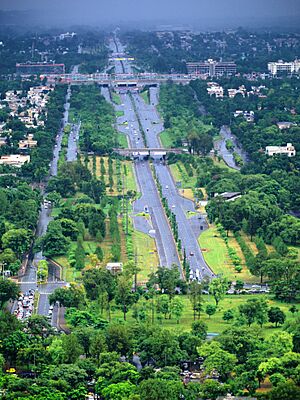
- Islamabad is a planned capital city whose construction began in the 1950s.
- Ravi City is a huge riverfront and urban development project expected to house 25–35 million people.
- Gwadar is a port city built as part of the China–Pakistan Economic Corridor.
- Faisalabad was established by the British as a planned industrial city.
- Jauharabad is a planned town in Punjab.
- Sargodha was established by the British for air defense.
- Other planned areas include Bahria Town (privately built), Defence Housing Authority, Clifton, Karachi, WAPDA Town, DHA City, and LDA City.
Palestinian territories
- Rawabi is a planned city in the Palestinian territories.
People's Republic of China
Many ancient cities in China, especially in the North China Plain, were carefully designed using fengshui principles, with square walls and straight road grids. Famous examples include Chang'an (in the Tang dynasty) and Beijing. In modern China, many special economic zones are developed from scratch, such as Pudong, a new district of Shanghai.
Philippines
Quezon City was a planned city envisioned by President Manuel L. Quezon. It was the national capital from 1948 to 1976. Planned districts include Santa Mesa Heights, Diliman Estate, and various Housing Projects. Other planned cities include:
- Baguio
- Trece Martires, Cavite
- Island Garden City of Samal
- Palayan, Nueva Ecija
Saudi Arabia
King Abdullah Economic City is a future planned city along the Red Sea. In 1975, Jubail was chosen as a new industrial city. It provides half of Saudi Arabia's drinking water through desalination.
Singapore
Singapore introduced the new town planning idea with Queenstown, built from 1952 to 1973. Today, most of Singapore's public housing buildings are organized into 22 new towns. Each new town is designed to be self-sufficient, with shops, industrial areas for jobs, schools, hospitals, parks, and sports facilities. Singapore's success in new town design was recognized when Tampines New Town won the World Habitat Award in 1992.
South Korea
- Sejong was planned as a new capital in 2007 and is now the main administrative capital, with many government agencies moving there. It aims for a population of 800,000.
- New Songdo City is a planned international business center built on reclaimed land near Incheon. It is one of the largest private development projects in the world.
- Gwanggyo newtown, located near Seoul, was planned to house over 31,000 families and include a provincial office and convention center.
- Since the 1990s, many planned communities were built in the Seoul Metropolitan Area to help with housing needs, including Bundang, Ilsan, and Pangyo.
Taiwan
After the Chinese Civil War, the government of China moved to Taiwan. They built many "military dependents' villages" as temporary housing, which later became permanent neighborhoods.
- The Taiwan Provincial Government moved to central Taiwan for safety, leading to planned communities like Guangfu New Village and Zhongxing New Village.
- In the 1970s, new cities like Linkou new town and Danhai New Town were planned to ease overcrowding in Taipei, but most did not fully succeed.
- Taichung's 7th Redevelopment Zone is a major planned community that became the new central business district of Taichung, with wide boulevards, apartments, and offices.
Turkey
- Some parts of Istanbul are being redeveloped and re-planned.
- The capital, Ankara, was built based on a plan and is still being re-planned.
- Atça, Aydın was rebuilt after the Turkish Independence War based on Paris's plan.
- Other planned cities include Erzincan, Karabük, Kars, Kayseri, and Konya.
United Arab Emirates
- The capital city of Abu Dhabi is a planned city.
- Certain new parts of Dubai are also planned.
- Masdar City is a planned mixed-use residential and commercial area designed to be sustainable.
South Asia
Ancient History of Planning
The Indus Valley civilization (around 3300 BC) in present-day Pakistan and India had advanced urban planning. Cities like Mohenjo-daro and Harappa were laid out in a perfect grid pattern, similar to modern cities. They had the world's first urban sanitation systems, with wells and covered drains for wastewater.
Medieval History of Planning
Several medieval Indian cities were planned:
- Ahmedabad in Gujarat (1411)
- Jaipur in Rajasthan (1727), the capital of Rajasthan state.
- Madurai in Tamil Nadu, known for its lotus-like symmetry.
- Fatehpur Sikri in Agra, planned by the Mughal emperor Akbar the Great.
- Vijayanagar and Hampi in Karnataka, capitals of the Vijayanagara Empire.
Modern History of Planning in India
India has many planned cities. After gaining independence, new states were formed with planned capital cities.
- Navi Mumbai, Noida, Dholera, Amaravati, New Delhi, and Chandigarh are prominent examples.
- Noida was a successful planned city, divided into sectors with residential and commercial zones.
- Bhubaneshwar (capital of Odisha), Bidhannagar, Kolkata (Salt Lake City), Bokaro Steel City, Chandigarh (India's first planned city), and Durgapur (India's second planned city) are other major examples.
- Navi Mumbai is a large planned city with a population of 2.6 million.
- Naya Raipur is the upcoming capital of Chhattisgarh.
Planned Cities in Europe
History of European Planning
Planned settlements in Europe date back to ancient Greece and Rome. The Romans built many towns with grid streets and water systems. Most planned settlements in medieval Europe were created between the 12th and 14th centuries. Landlords founded new villages and towns to gain economic, political, or military power. While many remained small, some became important cities like Munich and Berlin.
Belarus
Belarus has several planned towns built in the 1950s–1970s during rapid construction projects.
- Salihorsk was built for workers of the Belaruskali company.
- Svietlahorsk was built for power plant and chemical factory workers.
- Navapolatsk was built for oil refinery workers.
Belgium
- Tongeren grew from a Roman army camp into an important center with a grid plan.
- Charleroi was founded in 1666 as a stronghold near the French border.
- Linkeroever (Left Bank) in Antwerp was developed from the 1920s as a new urban community.
- Louvain-la-Neuve was built starting in the 1970s as a new university town, with a pedestrian-friendly center above car traffic.
Bosnia and Herzegovina
- Slobomir is a new town near Bijeljina, meaning "city of freedom and peace."
- Andrićgrad is a town under construction by film director Emir Kusturica in Višegrad.
Bulgaria
- The cities of Stara Zagora and Kazanlak were rebuilt as planned cities after being destroyed in the 1877–1878 Russo-Turkish War.
- Dimitrovgrad was planned as a key industrial center.
Croatia
- Červar-Porat is a resort town built as a planned town in the 1970s.
- Raša in Istria was built as a "new town" in 1936–1937.
- Novi Zagreb (New Zagreb) was constructed in the 1960s and 1970s on the other side of the Sava river, consisting of residential buildings.
Czechia
- The New Town of Prague was founded in 1348 by Emperor Charles IV, making Prague one of Europe's largest cities by area.
- Poruba and Havířov were built in the 1950s as satellite towns for coal-mining and steel workers.
- Prague was expanded with large housing estates, or "new towns," in the 1970s and 1980s, such as Severní Město (Northern Town) and Jižní Město (Southern Town).
Denmark
- Fredericia was founded in 1650 as a planned market and military town.
- Esbjerg was built in 1868 as a port city.
- More recent examples include Græse Bakkeby and Ørestad (a district of Copenhagen), planned to boost development in the Copenhagen/Malmö region.
- In 2017, plans for Vinge, a new town for 20,000 people, were approved.
Finland
- Helsinki was made the capital of Finland in 1812, and its city center was rebuilt with a planned design.
- Raahe, founded in 1649, was the last town in Finland ordered to be built on completely uninhabited land.
- Vaasa was rebuilt in 1862 after a fire, with a new planned layout.
- Hamina has a unique star-shaped fortress and circular town plan based on a 16th-century Italian design.
- Tapiola is a post-war "garden city" near Espoo.
- Hervanta in Tampere is a satellite city built from the 1970s, designed to be as independent as possible with a university campus and company offices.
France
- Many new cities called bastides were founded from the 12th to 14th centuries in southwestern France to replace destroyed cities and organize defense. Examples include Monpazier and Villeréal.
- Le Havre was ordered by Francis I of France in 1517 as a new port. It was rebuilt in a modern style after being destroyed in World War II.
- Cardinal Richelieu founded the small Baroque town of Richelieu, which remains largely unchanged.
- A program of "new towns" (villes nouvelles) was developed in the mid-1960s to control city expansion. Ten were created, including Cergy-Pontoise and Marne-la-Vallée near Paris.
- La Défense in Paris is a planned business district built in stages since the 1950s.
Germany
Planned cities in Germany include:
- Bayreuth (medieval new city)
- Bremerhaven (19th-century seaport)
- Berlin – Friedrichstadt (1691)
- Eisenhüttenstadt (the "first socialist town")
- Karlsruhe (roads spread out like a fan from the castle)
- Ludwigsburg (planned new capital for the duke of Württemberg)
- Mannheim Quadratestadt (squares named like a chessboard)
- Wolfsburg (1938, built for Volkswagen factories)
- After World War II, several towns were built for people who had been displaced, like Espelkamp.
Greece
Planned cities in Greece are:
- Lakki (1930s, built by Italians for military personnel)
- Nea Alikarnassos (1925, for Greek refugees)
- Orestiada (1922, for Greek refugees)
- Piraeus (planned to be the main port of Athens)
- Sparta (1834, built next to the ancient city)
Hungary
All Hungarian planned cities were built in the second half of the 20th century during a period of rapid industrialization.
- Dunaújváros was built for workers of a large steel factory.
- Tiszaújváros was built alongside a chemical factory.
- Kazincbarcika grew quickly after a factory was founded.
- Tatabánya developed into a mining and industrial center.
- Beloiannisz (a village) was planned in the 1950s for Greek refugees.
Ireland
In Ireland, "new town" often refers to planned towns built after World War II.
- Shannon was the first new town, started in 1961. It is now an important economic center.
- In 1967, four towns were planned in County Dublin: Blanchardstown, Clondalkin, Lucan, and Tallaght. These areas, previously small villages, were greatly expanded. Each now has about 50,000 people.
- The most recent new town is Adamstown in County Dublin, where building began in 2005.
Italy
- Palmanova is a famous example of a planned Renaissance city, built in a star shape.
- In the early 20th century, during Benito Mussolini's government, many new cities were founded, like Littoria (now Latina).
- The great Sicilian earthquake of 1693 led to the complete rebuilding of many towns with new plans.
- Crespi d'Adda, near Milan, was the first "Ideal Worker's City" in Italy, built near a cotton factory. It is now a Unesco World Heritage site.
- Cusano Milanino was built in the early 20th century as a "new green city" with parks and boulevards.
Lithuania
- Elektrėnai was established in 1961 as a planned city for power plant workers.
- Visaginas was established in 1975 for nuclear power plant workers.
Malta
- The fortified cities of Senglea and Valletta were built on a grid plan by the Knights of Malta in the 16th century.
- Paola (also known as Raħal Ġdid or New Town) was built on a grid plan.
- San Ġwann and Santa Luċija were built as planned cities in the 1960s and 1970s.
Netherlands
- Flevoland, one of the 12 provinces, was entirely reclaimed from the sea. Its capital is Lelystad, and its biggest city is Almere (founded in 1975).
- Several "New Villages" were built in Flevoland, like Emmeloord and Nagele.
- Other new towns include Hoofddorp and IJmuiden near Amsterdam, and Hellevoetsluis near Rotterdam.
- Elburg is an example of a planned city from the medieval period.
North Macedonia
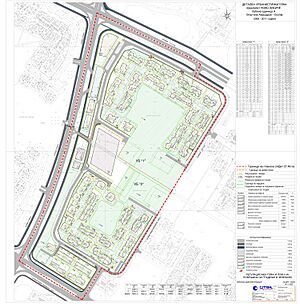
The Municodality of Aerodrom within the city of Skopje is a planned community.
Norway
- Oslo: After a big fire in 1624, King Christian IV moved the city behind a fortress. The new town, Christiania, was laid out in a grid.
- Kristiansand was founded in 1641 by King Christian IV. It was also built behind a fortress with a grid system.
Poland
Four cities are great examples of planned communities in Poland: Zamość, Gdynia, Tychy, and Nowa Huta. Their different designs show the changing ideas of ideal city planning over time.
Nobleman's Republic Era
During the Renaissance, Polish nobles built their own "private" cities. Jan Zamoyski founded Zamość in the 16th century, planned by architect Bernardo Morando like an "ideal city." Zamość is now a World Heritage Site.
Interwar Period
After World War I, Poland needed a commercial seaport. Gdynia was built from scratch, growing from a small fishing village to a city of over 126,000 people in less than 20 years. Its Central Business District shows Art Deco and Modernist styles.
Socialist Realism Era
After World War II, the Communist government built cities that reflected socialist ideals. Nowa Huta (now a district of Kraków) and Tychy were built as examples of the "proletarian future" of Poland.
Portugal
Vila Real de Santo António was built after the 1755 Lisbon earthquake, using a similar planned layout as the rebuilt capital, Lisbon.
Romania
- The cities of Brăila, Giurgiu, and Turnu Severin were rebuilt with new plans in the early 19th century.
- Alexandria and Călărași were built completely new at the same time.
- Victoria was built by the communist government starting in the late 1940s.
- Motru dates to the 1960s.
Russia

- Saint Petersburg was built by Peter the Great starting in 1703 as a planned capital city, especially for maritime trade with Europe.
- Magnitogorsk is an example of a planned industrial city from Stalin's 1930s five-year plans.
- The Avtozavodsky district of Tolyatti is a planned industrial city from the Soviet post-war era.
- Kostomuksha was built as a mining town in the 1970s–1980s through Finnish-Russian cooperation.
- Zelenograd was planned as a center for Soviet electronics and microelectronics, known as the "Soviet/Russian Silicon Valley."

Serbia
- Novi Beograd (New Belgrade) is a part of Belgrade, built on undeveloped land starting in 1947. It is the fastest-growing area in Serbia.
- Drvengrad (Wooden Town) is a traditional village built by film director Emir Kusturica for his film Life Is a Miracle.
Slovakia
- Partizánske was established in 1938–1939 by Jan Antonín Baťa (of the shoe company) as a settlement for shoe factory workers. It was renamed Partizánske in 1949.
- Svit was established in 1934 by Jan Antonín Baťa for his workers.
- Nová Dubnica was planned by architect Jiří Kroha as an ideal town. Construction started in 1951, and its town center is a good example of Stalinist architecture in Slovakia.
Slovenia
Nova Gorica was built after 1947, right next to the new border with Italy, where the town of Gorizia remained.
Spain
- In the 18th century, King Charles III started the New Settlements plan, bringing immigrants to Sierra Morena and establishing about forty new settlements, like La Carolina, with a rectangular grid design.
- Under Francisco Franco, the National Institute of Colonization built many towns and villages.
- Tres Cantos, near Madrid, is a successful new town built in the 1970s.
- Newer parts of large cities, like the Salamanca district or Ciudad Lineal in Madrid, and the Eixample in Barcelona, are also planned.
Sweden
- Gothenburg was planned and built as a major fortified city from 1621.
- Karlskrona was planned and built as a major city and naval base from 1680.
- Vällingby, a suburb, is an example of a new town from after 1950.
- Kiruna was built from 1898 because of a large mine.
Ukraine
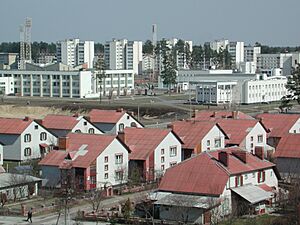
- Odesa was built as a planned city in the 18th century. The same engineer also planned Voznesensk and Ovidiopol.
- During the Soviet period, many cities had "Sots-gorodok" (socialist town) neighborhoods. Special cities like "Atomgrad" (for nuclear scientists) and "Goroda Energetikov" (for power workers) were also built, such as Teplodar and Enerhodar.
- Horishni Plavni, founded in the 1960s, is a successful planned city based on iron ore mining.
- Prypiat was built in 1970 for workers of the Chernobyl nuclear power plant. It was abandoned in 1986 after the Chernobyl nuclear disaster. Most of its residents were moved to Slavutych, which was planned and built for them.
United Kingdom

The Romans planned many towns in Britain. Winchelsea (1280) and Salisbury (early 13th century) are considered early post-Roman new towns. The Edinburgh New Town (1766) is a famous example of Georgian architecture.
England
The term "new town" in the UK often refers to towns built after World War II under the New Towns Acts. These were influenced by the garden city movement (started around 1900) and aimed to house people whose homes were destroyed in the war or to move people out of crowded city areas.
- The first "first generation" new towns around London (1946) included Stevenage and Basildon.
- Other new towns from this era include Welwyn Garden City, Hatfield, Letchworth, Hemel Hempstead, Bracknell, Harlow, and Crawley.
- New Towns in the North East included Newton Aycliffe, Washington, and Peterlee.
- "Third-generation" towns launched in the late 1960s were larger, like Milton Keynes, designed from the start to be a new city with a unique grid road system.
- New towns around Birmingham included Redditch, Tamworth, and Telford.
- Many new towns were designed to be car-friendly with roundabouts and grid-based roads.
- Some new towns, like Harlow and Peterlee, included public art and cultural programs.
- Poundbury in Dorset is an experimental "new town" started in the 1990s, using traditional architectural styles.
Northern Ireland
- Building of Craigavon began in 1966, intended as a linear city, but the plan was mostly abandoned.
- Derry was the first ever planned city on the island of Ireland, started in 1613 with a walled city and four gates for defense.
Scotland
- Two "post-war new towns" were planned: East Kilbride (1947) and Glenrothes (1948).
- Later, Cumbernauld (1956), Irvine (1966), and Livingston (1962) were created. All are now among Scotland's most populated towns.
- Glenrothes was the first new town in the UK to hire a "town artist" to create public artworks.
Wales
The only new towns in Wales are Newtown and Cwmbran. Cwmbran was built to create new jobs in the South Wales Coalfield.
Planned Cities in North America and the Caribbean
Canada
When Canada began settling its western lands, the Canadian Pacific Railway (CPR) played a big role in planning towns.
- The CPR decided where to put railway stations, which often determined where new towns would be built, like Medicine Hat and Moose Jaw.
- Sometimes, existing towns had to move to the new railway sites, like Calgary and Yorkton.
- The CPR also planned the layout of these towns, including business areas, warehouses, roads, and residential zones.
- Later, many "company towns" were planned and built in remote areas for mining and forestry, such as Corner Brook and Grand Falls in Newfoundland.
- In modern suburbs, "New Towns" like Leaside in Toronto and Mount Royal in Montreal were developed as planned middle-class suburbs.
- More recently, Bramalea and Erin Mills in Ontario were developed in phases with residential, commercial, and industrial areas.
- Cornell in Markham, Ontario, was built using New Urbanism concepts.
Mexico
- Tenochtitlan, the capital of the Aztec empire, was built on an island. After its destruction by Spanish conquistadores, Mexico City was built on its ruins.
- Puebla was built to be a Spanish settlement on the route between Mexico City and the port of Veracruz.
- Cancun in Quintana Roo is a planned city transformed from a forest into a global tourism destination.
United States
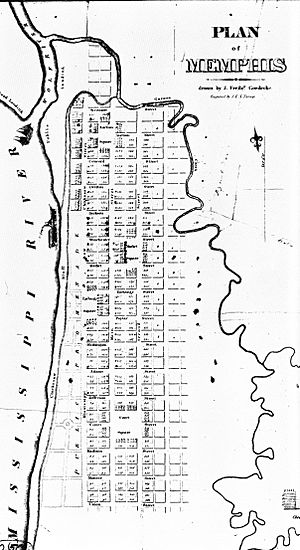
Colonial and Early Industrial Periods
- The first planned community in the United States was St. Augustine, planned in 1565.
- Early comprehensively planned towns included Charles Town (later Charleston, South Carolina), Philadelphia (1682), Williamsburg (1699), and Savannah (1733).
- The national capital, Washington, D.C., and several state capitals like Indianapolis and Salt Lake City were planned and built from scratch.
- In the 19th century, wealthy investors built "mill towns" like Lowell and Lawrence around textile mills.
- Pullman (1880s) was a famous company town founded by industrialist George M. Pullman.
- Gary, Indiana was founded in 1906 by the United States Steel Corporation for its new steel mill.
- Riverside, Illinois (1869) is considered the first planned suburb in the U.S.
- Shaker Heights, Ohio (1912) was planned as a suburban retreat from Cleveland.
Government-Led Schemes
- During the 1920s Florida land boom, communities like Coral Gables, Opa-locka, and Miami Springs were incorporated as fully planned "themed" communities.
- In the 1930s Great Depression, the Federal government built model towns like Arthurdale and three "Greenbelt Communities" (Greenbelt, Maryland, Greenhills, Ohio, and Greendale, Wisconsin) with surrounding natural areas.
- During World War II, the Manhattan Project built planned communities like Oak Ridge, Tennessee and Los Alamos, New Mexico to house scientists and workers in secret locations.
Postwar and Modern Planned Cities
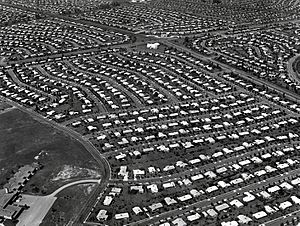
- The Levittowns (in Long Island, Pennsylvania, and New Jersey) were typical planned suburban communities of the 1950s.
- Many master-planned communities were built in states like California and Arizona during the housing boom of the 1960s, including Irvine and Mission Viejo.
- The modern era of planned cities began in 1962–1964 with Reston, Virginia, followed by Coral Springs, Florida, and Columbia, Maryland.
- New Urbanism has influenced newer planned cities like Seaside and Celebration (developed by The Walt Disney Company).
- Las Colinas (1973) in Irving, Texas, is a large master-planned community that is still growing.
- The Woodlands (1970s) near Houston is a major residential and commercial master-planned community.
- Newer towns like Mountain House, California, have strict growth boundaries to prevent merging with nearby cities.
- Ave Maria, Florida (2007) is a unique planned town centered around a Catholic university and church.
- Storyliving by Disney communities, like Cotino in Rancho Mirage, California, are new mixed-use planned communities.
Planned Cities in South and Central America
Colonial Cities in Spanish and Portuguese Administration
Colonial cities in Portuguese and Spanish America were often built with a specific plan, usually a grid layout with a central "Plaza de Armas" for authorities. These cities served different purposes, like administrative centers, ports, or mining towns.
Argentina
La Plata was planned in 1880 to replace Buenos Aires as the capital of the Buenos Aires Province. Its design uses a square shape with a central park and main diagonal avenues, copied in smaller blocks.
Brazil
Brasília
Juscelino Kubitschek, President of Brazil from 1956 to 1961, ordered the construction of Brasília to be the new capital. It was built in just 41 months, from 1956 to 1960. The main reason was to encourage development in Brazil's interior. Lúcio Costa, the main urban planner, designed the city to look like an airplane. Everything, from housing to industrial zones, follows this original plan.
Belo Horizonte
In 1889, Brazil became a republic, and a new state capital for Minas Gerais was needed. Belo Horizonte was chosen and designed by Aarão Reis. It was inaugurated in 1897, with a symmetrical layout of perpendicular and diagonal streets.
Goiânia
Goiânia was planned for 50,000 people with a concentric design, like spokes on a wheel, with the Praça Cívica (Civic Square) at the center. It became the state capital in 1937.
Other Planned Cities in Brazil
- Fordlândia was built by Henry Ford as a rubber plantation, but it failed.
- Other notable planned cities include Teresina (the first, 1842), Petrópolis, Boa Vista, Palmas, Londrina, and Maringá.
Chile
- Cities like Santiago and La Serena were planned in the 16th century.
- In the 18th century, authorities promoted new planned cities like Rancagua and Talca.
- After independence, more planned cities were founded to strengthen national control in remote areas, such as Puerto Montt and Temuco.
- In the 20th century, private planned communities for mining workers, called oficinas, were built, like Sewell.
Panama
While Panama City itself is not fully planned, areas like Costa del Este are. Costa del Este is an exclusive residential and business area with skyscrapers and green spaces, close to downtown. Other planned areas include Punta Pacifica and the former Canal Zone.
Venezuela
- Guayana City in Bolívar State was officially founded in 1961. It combines the old town of San Félix with the new town of Puerto Ordaz.
- Guayana City stretches 40 kilometers along the Orinoco River and is Venezuela's fastest-growing city due to its important iron, steel, and aluminum industries. It also has a large hydroelectric power plant.
- Because it was planned, Guayana City feels different from many other South American cities, with architecture and landscaping similar to U.S. suburbs from the 1950s.
Planned Cities in Oceania
Australia
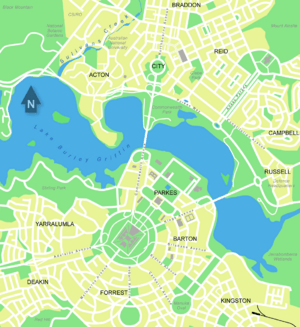
Australia's most famous planned city is Canberra, its capital, designed by American architect Walter Burley Griffin. The early central areas of Adelaide and Melbourne were also planned. Developers like Delfin Lend Lease have built large master-planned communities:
- Forest Lake, Queensland, Brisbane (completed 2004)
- The New Rouse Hill, Sydney
- Golden Grove, South Australia (completed 1991)
Adelaide

Adelaide was founded in 1836 by British and German colonists. The city was surveyed and planned quickly. Adelaide's design is praised for its grid layout, location, and large parklands.
Melbourne
Melbourne was planned as a free settlement in 1837 by Robert Hoddle. The plan included wide, parallel streets. Although Melbourne quickly grew beyond its original boundaries, the grid still defines much of the Melbourne city centre.
Canberra
Canberra, established in 1908, was planned as Australia's capital city after the six Australian colonies formed the Commonwealth of Australia. The land was previously farmland and forest. In 1912, American Walter Burley Griffin's design was chosen. Extensive construction, including creating Lake Burley Griffin, was needed. The city's roads, suburbs, and parks were all designed together.
New Zealand
New Zealand has several small "new towns" built for specific purposes:
- Kawerau (a mill town)
- Twizel and Mangakino (for hydroelectricity)
- Tūrangi (for the Tongariro Power Scheme)
- Martinborough was planned in the 19th century with streets laid out like the Union Flag.
- In 2006, construction began on Pegasus Town, a new planned town near Christchurch.
See also
 In Spanish: Ciudad planificada para niños
In Spanish: Ciudad planificada para niños
- Lists of purpose-built capital cities
- List of planned cities
- Company town
- Garden city movement
- Grid plan
- Housing estate
- Model village
- Urban planning
- List of urban planners
- Utopia


